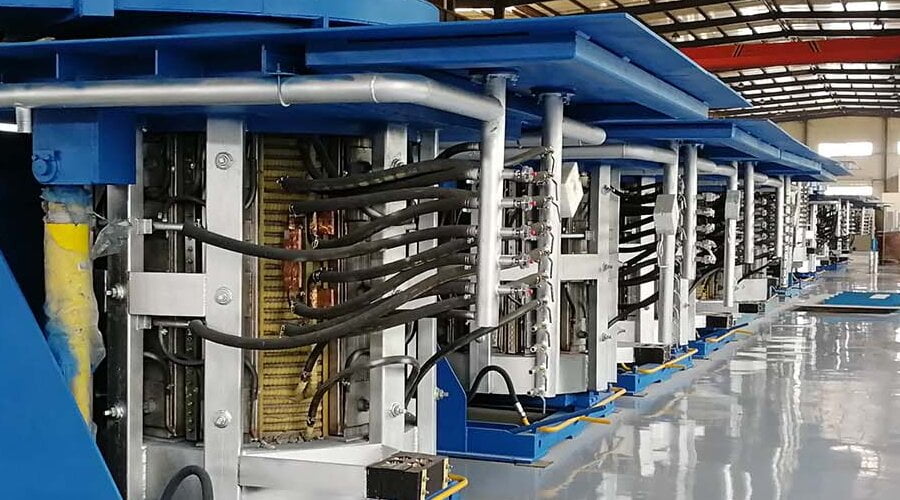Furnace lining refers to the furnace wall of induction melting furnaces or other furnaces used to refine metal. It is an important part of the working process of induction furnaces. The quality of furnace lining can directly affect the working efficiency of electric induction furnaces. As high-temperature smelting equipment, the temperature resistance of the furnace lining must be the main standard to judge the furnace lining. So how can we improve its temperature resistance?
The temperature resistance of induction melting furnaces lining mainly depends on the physical and chemical properties and mineral composition of the refractory used in the lining. On the premise of selecting raw and auxiliary materials, the sintering process is the key process to obtaining good microstructure of furnace lining to give full play to its high-temperature resistance. The densification degree of lining sintering is related to the chemical composition, particle size ratio, sintering process, and sintering temperature of refractories. After introducing the relevant factors, we will formally start to introduce the methods to improve the temperature resistance of the induction melting furnace lining.
1. Remove the Mica Paper When Building the Induction Melting Furnaces
One of the ways to improve the temperature resistance of the crucible induction furnace lining is to remove the mica paper when building the furnace.
2. Treatment of Crystal Quartz Sand for Induction Melting Furnaces Building
Manual selection: mainly remove lumps and other impurities;
Magnetic separation: magnetic impurities must be completely removed;
Dry ramming material: it must be dried slowly at a temperature of 200 ℃ -300 ℃ and kept for more than 4 hours.
3. Selection of Binder for electric induction furnace
Boron anhydride (B2O3) is used as a binder instead of boric acid (H3BO3), and the addition amount is 1.1% – 1.5%.
4. Selection and Proportion of Appropriate Furnace Building Materials:
(1) Selection of furnace building materials: it should be noted that not all quartz sands with SiO2 ≥ 99% can be used as furnace lining materials of induction furnaces. The important thing is the size of quartz grains. The coarser the grains, the less lattice defects, the better. (for example, crystal quartz sands have high SiO2 purity, white and transparent appearance.) The larger the furnace capacity is, the higher the requirements for grains are.
(2) Proportion of furnace building materials: Proportion of quartz sand for furnace lining: 6-8 mesh 10%-15%, 10-20 mesh 25%-30%, 20-40 mesh 25%-30%, 270 mesh 25%-30%.
5. Knotting of Furnace Lining
The quality of lining knotting is directly related to the sintering quality. When knotting, the sand particle size is evenly distributed without segregation. The density of the sand layer after knotting is high, and the probability of cracks after sintering is reduced, which is conducive to improving the service life of the induction furnace lining.
6. Knotting at the Bottom of the Induction Melting Furnaces
The thickness of the furnace bottom is about 280mm, which is filled with sand in four times. When knotting manually, uneven density is prevented everywhere, and the furnace lining after baking and sintering is not dense. Therefore, the feeding thickness must be strictly controlled. Generally, the thickness of sand filling is not more than 100mm/ time, and the furnace wall is controlled within 60mm. Multiple people are divided into shifts, with 4-6 people in each shift, and each time they tie knots for 30 minutes to change people. They rotate and rotate slowly around the furnace, with even force, so as to avoid uneven density.
7. Knotting of Furnace Wall
The thickness of the furnace lining is 110-120mm. Dry knotted materials are added in batches, and the distribution is uniform. The thickness of the filler is not more than 60 mm. Knot for 15 minutes (manually knot) until it is flush with the upper edge of the induction ring. After knotting, the crucible mold is not taken out, and it plays the role of induction heating during drying and sintering.
8. Observe Baking and Sintering Specifications
In order to obtain the three-layer structure of the furnace lining, the baking and sintering process is roughly divided into three stages:
- Baking stage: heat the crucible mold to 600 ℃ at the speed of 25 ℃ /h and 50 ℃ /h respectively, and keep it warm for 4h, in order to completely remove the moisture in the furnace lining.
- Semi-sintering stage: raise the temperature to 900 ℃ at 50 ℃ /h, keep the temperature for 3h, raise the temperature to 1200 ℃ at 100 ℃ /h, and keep the temperature for 3h. The heating rate must be controlled to prevent cracks.
- Complete sintering stage: during high-temperature sintering, the sintering structure of the medium frequency electric furnace crucible is the basis for improving its service life. With different sintering temperatures, the thickness of the sintering layer is insufficient, and the service life is significantly reduced.
In addition, when the medium frequency furnace is cold and started, it must be preheated at low temperature first, and then gradually increased, which can effectively improve the service life of the furnace lining.

